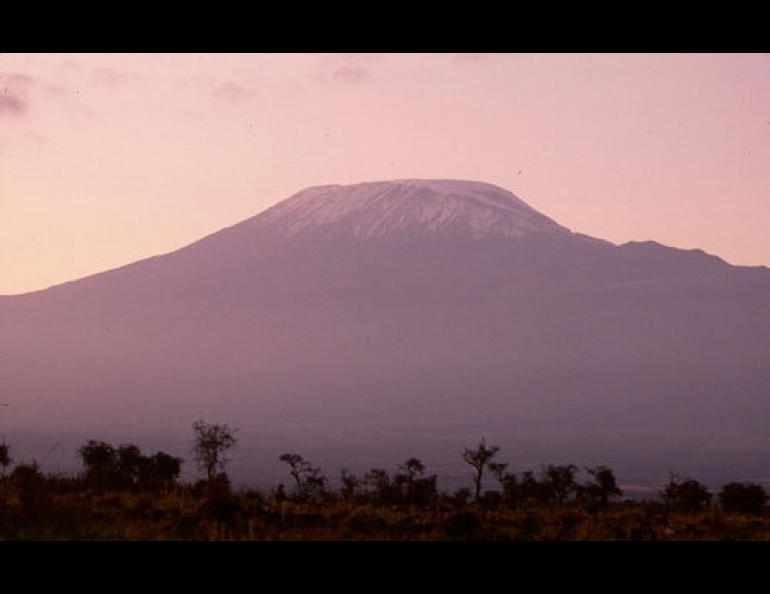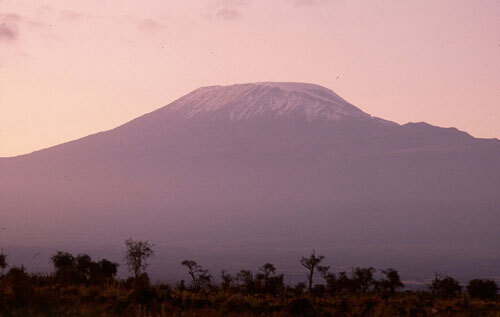
Drilling for permafrost on Mount Kilimanjaro
The words permafrost and equator don’t seem to go together, but ground that has remained frozen for at least two summers survives in high, cold refuges scattered near the globe’s midsection. A team of Alaskans is headed to Africa to try and find it.
Mount Kilimanjaro is an ancient volcano that rises to 19,331 feet above sea level in Tanzania, Africa. The mountain is closer to the equator than Fairbanks is to Anchorage, but it hosts a few disappearing glaciers and possibly the frozen ground you would encounter if you sunk a shovel into the tundra near Galbraith Lake.
Elena Sparrow of the University of Alaska Fairbanks’ International Arctic Research Center will travel to Africa in late September to direct a project that combines educational outreach with a nine-day trek up Africa’s highest peak. On the trek will be a half-dozen African students and UAF permafrost scientist and adventurer Kenji Yoshikawa.
“It’s part of the GLOBE (Global Learning Observations to Benefit the Environment) Program,” said Sparrow, head of education and outreach for the research center. “GLOBE was Al Gore’s brainchild, with the premise that if students understand what’s going on in their own backyard, they would better understand other places.”
Sparrow will set up a workshop for Africa high-school teachers in the relative lowlands of Arusha, Tanzania. Higher up in the atmosphere, Yoshikawa, Ming-Ying Wei from National Aeronautics and Space Administration, and teachers Mike O’Toole from Kentucky and Rogeline Bretteny from Africa will lead a group of about six South African high-school students on a nine-day trek to the top of Kilimanjaro.
When she was thinking of organizing the trip, Sparrow thought of Yoshikawa as one of few people who could attempt to drill for permafrost at 19,000 feet.
“Immediately, of course, he was interested,” Sparrow said. “He wants to see if there’s permafrost up there.”
Yoshikawa, who grew up in Japan but lives in Fairbanks, has a goal of finding where permafrost exists all over the world. He’s drilled in Mongolia, China, Tibet, Norway, Finland, and Sweden, and that’s just in the last three months. In early September, he’s been out drilling and maintaining his permafrost observatories in Alaska. Via e-mail from Barrow, he sent his thoughts about the Kilimanjaro trip.
His plan is to drill each day on the ascent of Kilimanjaro to see what effect elevation has on ground temperature. Yoshikawa sees two possibilities for where permafrost may be on Kilimanjaro. In 2004 there was a report of permafrost on the western slope of the mountain, at about 15,500 feet. The other possible permafrost site could be in the summit crater at about 19,300 feet. Yoshikawa said that when an ice cap covered the entire summit during a cold period called the Little Ice Age, permafrost didn’t have much of a chance to develop there. But now, some of the ground in the summit crater is exposed to frigid air, which could create permafrost.
“Current weather conditions, and the altitude, will be good for permafrost development,” he said.
Yoshikawa, who just recruited two Japanese friends and colleagues to help with the Kilimanjaro attempt, admitted he wasn’t sure in early September what sort of drill rig he would have porters help him carry up the mountain, or how he would perform in the thin air of the summit crater. But his resume includes similar accomplishments, like the time he skied across Antarctica to the South Pole, doing science all the way. He has shown a knack for solving problems in difficult terrain.
“Kenji is the ‘MacGyver’ of field research,” Sparrow said. “And, he’s an excellent role model because of his enthusiasm in working with students.”
After their trek and work on the mountain, Yoshikawa and his partners will descend to the town of Arusha, Tanzania, and meet with the teachers, Sparrow, and Martha Kopplin, Sparrow’s assistant at IARC. For updates on the expedition’s progress, go to http://www.xpeditiononline.com.





